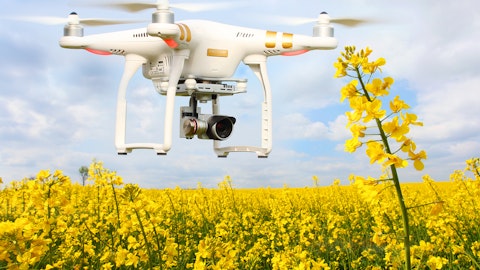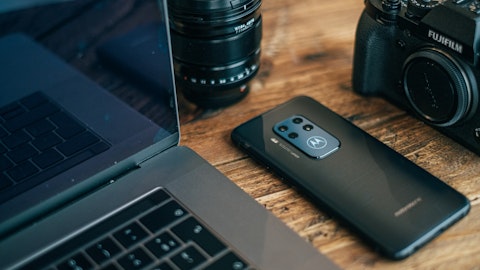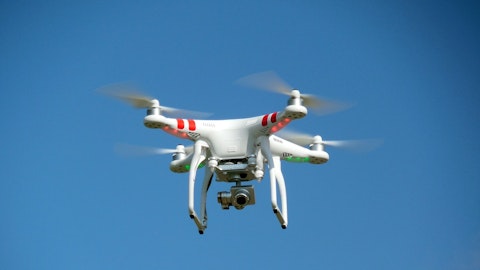Dr. Fermi Wang: I will take on the first question. I will ask Brian to take on the second question. The first question is about our — how Conti played into the two numbers. I think Conti’s contribution with the current funnel is little — and there are some of them. But however, I think that we expect that this number of countries impact to our funnel will start showing up in the next funnel next year. And also, we expect that we don’t have any Conti contribution in one business yet.
Brian White: And related to your question on normal seasonality in Q1, of course, normal is difficult to define. But the way we looked at it is taking a five-year average. And in that case, the five-year average for Q1 would be a sequential decrease of 4%. And so, as we sit here today, we think that the decrease going into Q1 will be greater than that number. We don’t have perfect visibility at this point to what it will be, but we want to provide as much outlook as we can at this time.
Operator: The next question will be coming up shortly. One moment, please. And that question will be coming from David Kelley of Jefferies.
David Kelley: Maybe to follow up on the funnel discussion. You announced a couple of pretty meaningful driver monitoring wins, an e-mirror win as well. So, how should we think about maybe framing it as the interior contribution to the auto funnel versus say the ADAS and autonomous contribution to that funnel growth?
Dr. Fermi Wang: So, first of all, as you can see, for those kinds of design wins, design cycle is much shorter than ADAS because they are not really safety sensitive. So, that for ADAS projects, we usually look at in China, more than two years development, outside China up to four-year development. For this kind of internal design, usually, you can think about a 12- to 18-month cycle that you can get into production. So that’s why you start seeing more of those design wins. And that’s definitely an area that we want to be really having high market share, and that’s what we are doing. But that doesn’t mean we don’t focus on ADAS. In fact, on the contrary, I believe that we are doing well with ADAS as well as Level 2 plus. And hopefully, we can give you more design win activity in the future.
David Kelley: Okay. Got it. Thank you. And maybe a quick follow-up to your point, on kind of the time line of adoption, and specific to Conti, very early days, as you demonstrate with them to customers. But any early thoughts on time line to eventual revenue contribution with this partnership? Are you seeing OEMs push to accelerate development to integration and production time line faster in ADAS and autonomous as well?
Dr. Fermi Wang: Well, first of all, I will leave Conti to answer the potential revenue that they can generate with this relationship. But like we said before, any CV3 design win will take three, four years to get to revenue. And I don’t think the time line has changed.
Operator: The next question that we have will be coming from Joe Moore of Morgan Stanley.
Joe Moore: I wonder if you could talk to the pace at which that funnel can start to turn to revenue. I think it’s a six-year kind of time line that you talked about. I assume that’s pretty back-end loaded, given that your number is so much bigger than what you’re shipping now. But can you just give us a sense for how quickly that revenue can roll in? And then, how much of that is still — I don’t want to — be too precise, but I know there’s probability weighting on some of it. Can you talk to how much of that we should think still as being a probability weighted event?
Louis Gerhardy: So, the methodology behind the funnel and how we discount both, one and pipeline didn’t change from our prior practice. And with regards to the distribution of the revenue through the six years of the funnel, it’s not linear, as you can imagine. It’s exponential in shape where the sixth year is much higher than the first year. And the reason for that would be the time to revenue that Fermi was just describing in a prior question, but it’s also very significantly driven by increased penetration rates of these new technologies. And then most importantly, it’s actually the higher ASP of the products that we’ll be selling in each of these six years. For example, CV3 contributes revenue in years 5 and 6 like we expect, the ASP per chip is much higher than it would be for, say, a DMS, CMS win with a CD25 product. So, those are the factors that caused it to be exponential in shape, not linear.
Operator: The next question that we have is coming from Kevin Wang of Stifel.
Jeremy Kwan: This is Jeremy Kwan calling on behalf of Tore from Stifel. I guess, maybe a question first on the ASPs. Can you give us any more color in terms of where they stand today? And I understand that once CV3 starts contributing, that’s going to grow up even more significantly. But can you help us just give us more details on where they are today and where you see that? And when you said it’s going to grow 20% this year, is that for the fiscal year or…
Dr. Fermi Wang: Yes. I think the comment’s for this fiscal year. It was at high single digits and now I think it’s above $10 ASP right now. And the major contribution comes from the increased sales of our computer vision chip. And in fact, that’s probably the biggest items which help us to continue to get a higher ASP. Now with the CV5 really getting into a ramp-up in production and we start sampling CV3, I also expect that our ASP will continue to this up trend.





